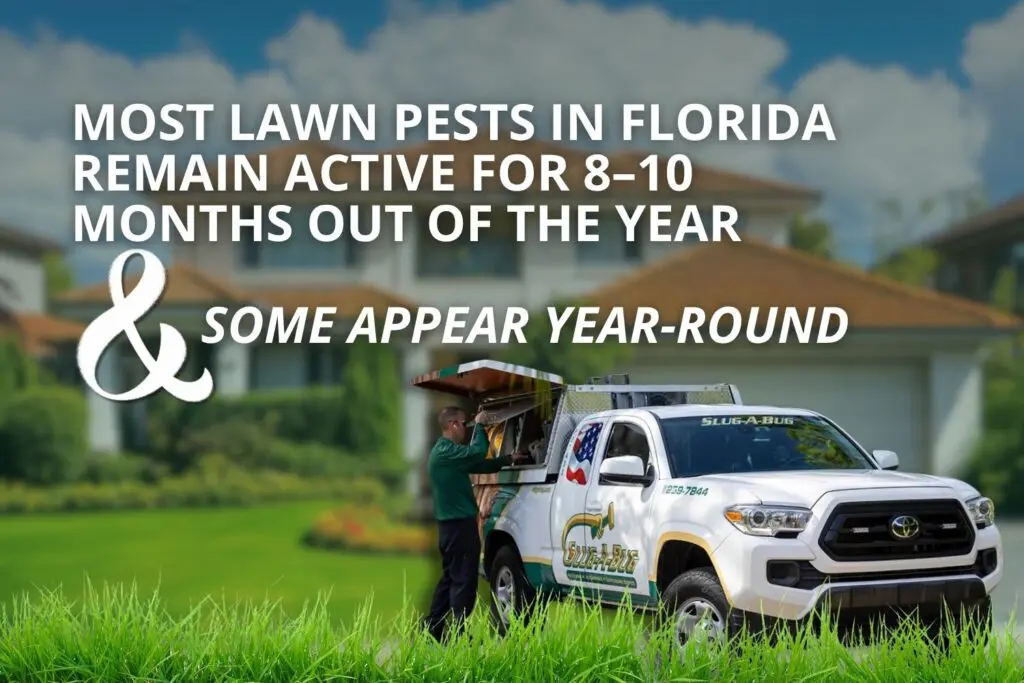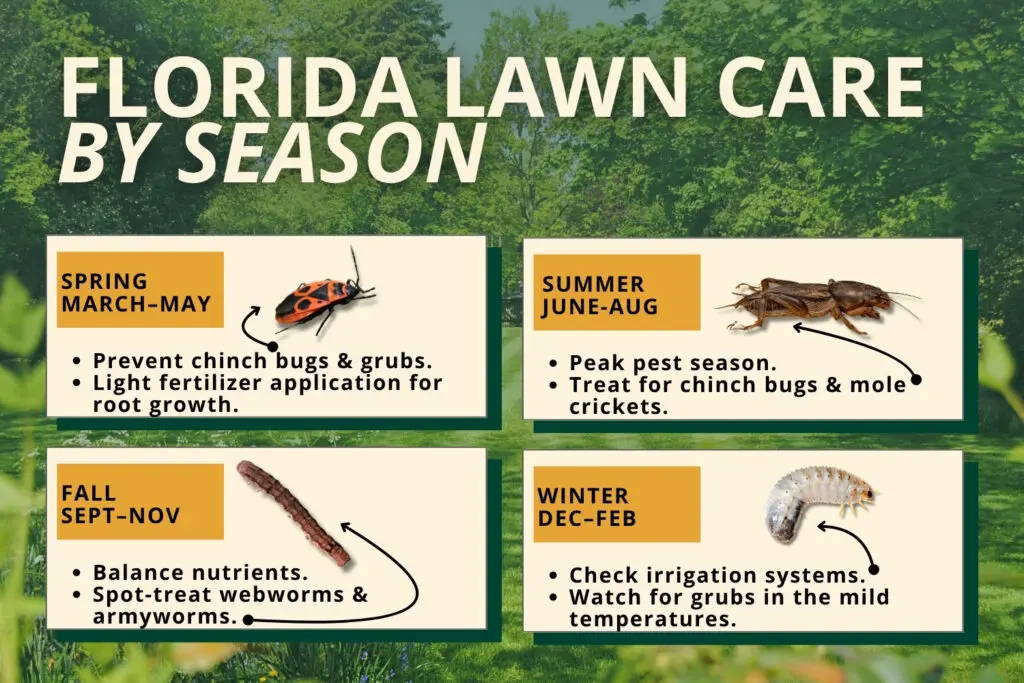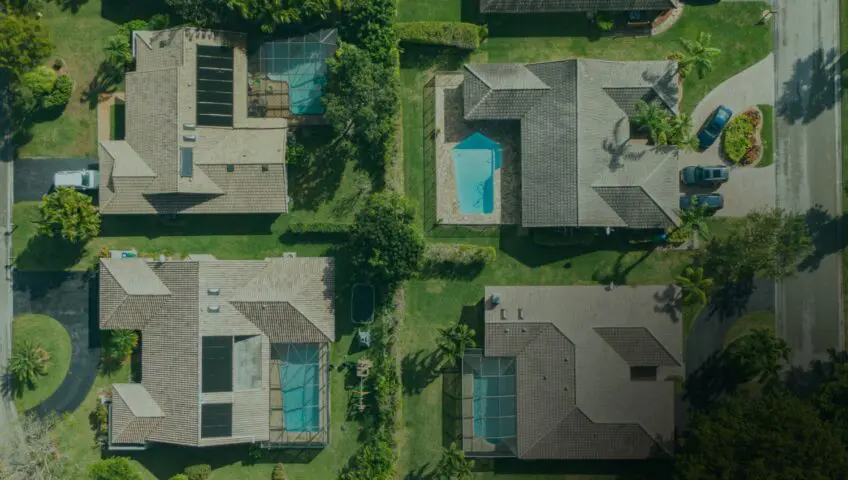If you’ve ever spent a weekend patching brown spots in your Florida lawn only to watch them reappear a month later, you’re not alone. Lawn pest control is a year-round issue across the state, quietly feeding on grass roots, blades, and stems while you’re focused on mowing and watering.
True lawn health isn’t just about fertilizing or cutting the grass. It’s about understanding how pest activity, moisture levels, and soil nutrition all connect. At Slug-A-Bug, that’s the foundation of every service.
This guide breaks down what makes Florida lawns vulnerable, how pests take hold, and what practical steps you can take to maintain a strong, pest-resistant yard.
Why Florida Lawns Face Unique Pest Challenges
Florida’s warmth and humidity create a paradise for turf pests. The same growing conditions that keep lawns lush also allow insects to feed and reproduce continuously. Unlike in northern states, there’s no long freeze to reset the pest cycle.
According to the University of Florida IFAS Extension, pest activity can occur during 10 to 11 months of the year, depending on location.
Homes along the coast and throughout Brevard County are especially prone to turf-damaging insects due to sandy soils, which dry quickly and stress the grass during heat spells.
Most common lawn pests in Florida:
- Chinch bugs: Small insects that thrive in St. Augustine grass and cause irregular, dry-looking patches.
- Sod webworms: Caterpillars that feed on grass blades at night, leaving chewed edges or thinning turf.
- Mole crickets: Burrowing insects that tunnel through soil, uprooting grass and exposing roots to heat.
- Grubs: Larvae that feed on the roots of various turf species, especially in watered or fertilized lawns.
- Armyworms: Highly destructive caterpillars known for feeding in large groups during summer.
Slug-A-Bug regularly encounters all five species in Brevard County neighborhoods, especially after long stretches of rain followed by sun.

How Lawn Care and Pest Control Support Each Other
Slug-A-Bug takes an integrated approach to outdoor health. Lawn pests usually target weak or stressed grass, so the key to lasting pest control is improving overall turf conditions.
That’s why our lawn and ornamental services include both pest management and ongoing lawn care programs.
When turf is healthy, roots grow deeper, moisture distributes evenly, and pests are less likely to gain a foothold. This balance between pest prevention and plant nutrition forms the foundation of Integrated Pest Management (IPM).
Slug-A-Bug’s integrated lawn care services include:
- Fertilization with slow-release and micronutrient blends
- Targeted insect control for turf and ornamental plants
- Fungus and disease prevention treatments
- Weed suppression for healthier root zones
- Irrigation and moisture management support
A healthy lawn doesn’t just look greener; it also recovers faster when pests do appear.
The National Association of Landscape Professionals notes that lawns receiving both fertilization and pest management recover 30% faster from insect stress than lawns treated for pests alone.
Spotting Early Signs of Lawn Pest Activity
Catching pest problems early is the easiest way to avoid expensive damage. Florida’s turf pests often start feeding in one section of the yard and spread quickly if conditions stay favorable.
Early warning signs to look for:
- Grass turning yellow or gray despite watering
- Dry, straw-colored patches that enlarge over time
- Blades with visible bite marks or ragged edges
- Soil that feels loose or spongy when walked on
- Birds or raccoons that dig small holes for grubs
- Areas of turf that lift easily, revealing chewed roots
Testing a small square of grass by gently tugging at it can help. If it pulls up like a loose carpet, grubs or mole crickets may be tunneling underneath.

Environmental Triggers That Attract Lawn Pests
Lawn pests don’t appear randomly. They thrive in specific conditions that many Florida homeowners unintentionally create.
Top environmental triggers include:
- Overwatering: Creates moist soil that attracts grubs, mole crickets, and fungal diseases.
- Underwatering: Weakens roots and makes lawns more appealing to chinch bugs.
- Cutting grass too short: Exposes soil to heat stress and eliminates protective canopy layers.
- Excess nitrogen: Encourages lush, weak growth that insects love to chew on.
- Ignoring thatch buildup: It provides shelter for pests and cuts off oxygen to roots.
Slug-A-Bug’s technicians check for these stress factors during each service visit. Adjusting irrigation timing or mowing habits can make as much difference as a pest treatment itself.
UF IFAS studies show that lawns with excessive irrigation have 50% more grub infestations than properly watered turf.
Timing Treatments for Maximum Effect
Lawn pest control is most effective when applied before populations peak. Because Florida’s pest pressure varies seasonally, timing makes or breaks the success of treatment.
Seasonal guide for Central Florida homeowners:
- Spring (March–May): Begin preventive applications for chinch bugs and grubs. Fertilize lightly to encourage root growth.
- Summer (June–August): Highest pest pressure. Focus on chinch bug and mole cricket control while managing irrigation and mowing height.
- Fall (September–November): Maintain nutrient balance with potassium-rich fertilizers and spot-treat for webworms and armyworms.
- Winter (December–February): Pest activity slows, but mild winters can allow grubs to keep feeding. Inspect and service irrigation systems to prepare for spring.
Slug-A-Bug builds these seasonal treatments into recurring lawn care plans, ensuring coverage aligns with your yard’s soil type and grass species.
Common Professional Treatment Methods
Professional-grade pest control isn’t just about spraying. It’s about precision and consistency. Slug-A-Bug’s technicians are trained to target both the pest and the underlying cause.
Key treatment practices:
- Inspection and Identification: Determine which pest species are present using soil samples or visual confirmation.
- Soil Evaluation: Measure pH, nutrient levels, and thatch depth to identify root stress.
- Selective Application: Apply eco-conscious insecticides or biological controls to affected areas.
- Follow-Up Monitoring: Reassess turf health and adjust fertilization or irrigation based on progress.
This approach prevents over-treatment while ensuring pests don’t return. Combining pest management with soil and turf adjustments improves resilience naturally.
The Science Behind a Healthy Florida Lawn
Florida lawns rely on balance. Too much fertilizer invites insects; too little creates stress. Similarly, overwatering can suffocate roots just as quickly as drought can. The science of lawn pest prevention comes down to creating an environment where beneficial organisms outcompete harmful ones.
Slug-A-Bug encourages clients to view their lawns as living ecosystems. Earthworms, microbes, and even certain predatory insects help maintain soil structure and pest balance. Sustainable pest control protects those beneficial organisms while managing the destructive species.
A 2023 UF IFAS lawn care report found that implementing Integrated Pest Management reduced pesticide use by 42% while improving soil organic matter by 15% in test properties across central Florida.
Other Related Questions
Can lawn insects damage ornamental plants too?
Yes. Many turf pests also migrate to garden beds. Combining lawn and ornamental treatments keeps the whole landscape protected.
Should pest control continue in winter?
Yes, but at a lower frequency. Some pests stay active underground during mild Florida winters, making maintenance important.
Can irrigation practices affect pest prevention?
Absolutely. Overwatering invites root-feeding pests and root rot or even fungus. Calibrating irrigation systems helps control moisture and pest conditions together.
Is it possible to restore a heavily damaged lawn?
Yes. With aeration, reseeding, and an ongoing pest management plan, most Florida lawns can recover over a few growing cycles.
When to Contact a Professional
If you’re seeing recurring lawn discoloration, soil tunnels, or brown areas that won’t bounce back after watering, it’s time for a professional inspection. Many pest infestations start small but quickly escalate with Florida’s weather.
Slug-A-Bug’s specialists are trained in both entomology and turf science. We identify which pest is present, treat the problem precisely, and help you make changes that protect your lawn long-term.
Our lawn and ornamental programs keep pests under control without harming beneficial insects or nearby landscaping.
Conclusion
Smart lawn pest control isn’t about reacting after damage appears. It’s about prevention, timing, and understanding how Florida’s environment shapes pest behavior. Homeowners who focus on soil health, watering habits, and professional inspection schedules save money and enjoy greener lawns throughout the year.
By combining pest management with regular fertilization, irrigation checks, and soil testing, Slug-A-Bug helps Brevard County homeowners protect their investment while keeping outdoor spaces healthy and sustainable. A little proactive care goes a long way toward a stronger, pest-free lawn.
